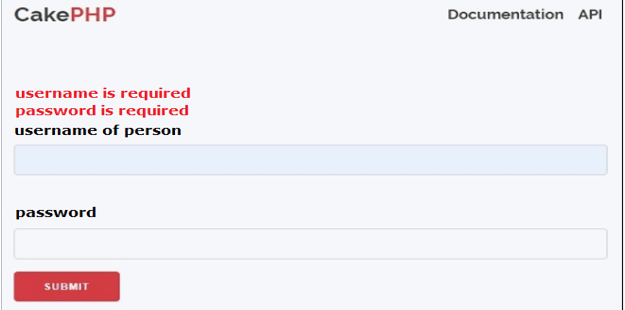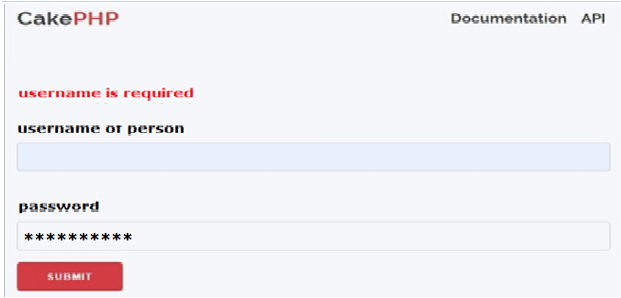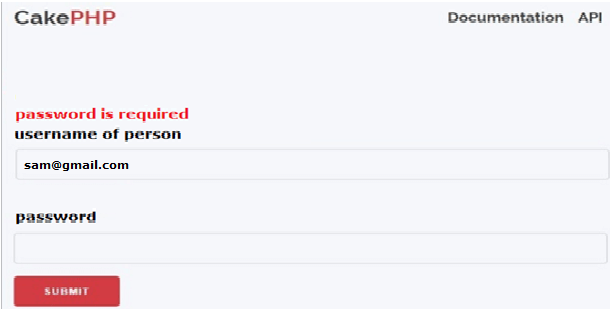CakePHP is an open-source tool used to implement dynamic programming applications as well as it provides a different kind of functionality to the developer. Validation is one of the functionalities that is provided by the CakePHP, by using validation we can provide the validation to the arbitrary arrays of data as per our requirement. In CakePHP, we need to build the entities before the data validation in terms of shape and size. Here we also need to consider default entities, these entities will be validated before the conversation of entities. We can also apply validation rules as per our requirements.
Start Your Free Software Development Course
Web development, programming languages, Software testing & others
What is CakePHP Validation?
Information approval is a significant piece of any application, as it assists with ensuring that the information in a Model adjusts to the business rules of the application. For instance, you should ensure that passwords are somewhere around eight characters in length, or guarantee that usernames are special. Characterizing approval rules makes structure dealing with a whole lot simpler.
There are various perspectives to the approval cycle. What we’ll cover in this segment is the model side of things. Basically: what happens when you call the save () technique for your model. For more data about how to deal with the showing of approval blunders.
CakePHP Validation Methods
Now let’s see different validation methods in CakePHP as follows.
1. Add
Adds another standard to a field’s standard set. On the off chance that subsequent contention is a cluster, the rules list for the field will be supplanted with second contention and third contention will be overlooked.
Syntax
Add(string $specified field, array|string $specified name, array|Cake\Validation\ValidationRule $required rule [])
Explanation
In the above syntax, we use the add method with different parameters. In the above syntax specified name is used to define the name of the rule that we need to add. The array is used to define this rule or multiple rules as per requirement and this returns $this.
2. allowEmpty
By using this method, we can allow empty field
Syntax
allowEmpty(string $specified field, boolean|string|callable $whentrue, string|null msgull)
Explanation
In the above syntax, we use the add method with different parameters. In the above syntax specified name is used to define the name of the rule that we need to add. A boolean parameter is used to indicate when we empty we need to allow, here we can also validate in terms of true or false when we perform create or update operation. The message is used to show the message field and this returns $this.
3. Alphanumeric
By using this method, we can add alphanumeric rules to the field as per our requirements.
Syntax
alphanumeric (string $specified field, string|null $Msgnull, string|callable|null $whennull)
Explanation
In the above syntax, we use the alphanumeric method with different parameters. In the above syntax specified name is used to define the name of the rule that we need to add. Adds another standard to a field’s standard set. In the event that subsequent contention is a cluster, the rules list for the field will be supplanted with second contention and third contention will be overlooked and it returns $this.
4. Creditcard
By using this method, we can add credit card rules to the specified field as per requirement.
Syntax
creditCard(string $specified field , string $type'all', string|null $msgnull, string|callable|null $whennull)
Explanation
In the above syntax, we use the credit card method to add the rule with different parameters. The field you need to apply the standard to.
The sort of cards you need to permit. Defaults to ‘a(chǎn)ll’. You can likewise supply a variety of acknowledged card types, for instance, ‘mastercard’, ‘visa’, ‘a(chǎn)mex’.
The mistake message when the standard falls flat. Either ‘make’ or ‘update’ or a callable that profits valid, when the approval rule ought to be applied and it returns $this.
5. Email
By using this method, we can add an email validation rule to the field as per our requirement.
Syntax
Email(string $specified field , boolean $checkMXfalse, string|null $msgnull, string|callable|null, $whennull)
Explanation
By using the above syntax, we can implement the email validation rule. The field you need to apply the standard too.
Regardless of whether to check the MX records.
The blunder message when the standard fizzles.
Either ‘make’ or ‘update’ or a callable that profits valid, when the approval rule ought to be applied.
6. maxLength
By using this method, we can apply string validation to the field.
Syntax
maxLength(string $specified field, integer $max, string|null $msgnull, string|callable|null $whennull)
Explanation
In the above syntax, we use the maxLength method with different parameters. Here the specified field is used to define the field to which we want to apply the rule, max is used to define the maximum length of string, msgnull is used to show an error message when the rule fails.
7. minLength
By using this method, we can apply string validation to the field.
Syntax
minLength(string $specified field, integer $min, string|null $msgnull, string|callable|null $whennull)
Explanation
In the above syntax, we use the minLength method with different parameters. Here the specified field is used to define the field which we want to apply the rule, min is used to define the minimum length of string, msgnull is used to show an error message when the rule fails.
How to Create CakePHP Validation?
Now let’s see how we can create CakePHP validation with examples as follows.?First, we need to make the changes in routes.php file as follows.
<?php
use Cake\Http\Middleware\CsrfProtectionMiddleware;
use Cake\Routing\Route\DashedRoute;
use Cake\Routing\RouteBuilder;
$routes->setRouteClass(DashedRoute::class);
$routes->scope('/', function (RouteBuilder $builder) {
$builder->registerMiddleware('csrf', new CsrfProtectionMiddleware([
'httpOnly' => true,
]));
$builder->applyMiddleware('csrf');
//$builder->connect('/pages',['controller'=>'Pages','action'=>'display', 'home']);
$builder->connect('validation',['controller'=>'Valid','action'=>'index']);
$builder->fallbacks();
});
?>
Now create an index.php file and write the following code as follows.
<?php
if($errors) {
foreach($errors as $error)
foreach($error as $mssg)
echo '<font color="red">'.$mssg.'</font><br>';
} else {
echo "There is no errors.";
}
echo $this->Form->create(NULL,array('url'=>'/validation'));
echo $this->Form->control('username of person');
echo $this->Form->control('password');
echo $this->Form->button('Submit');
echo $this->Form->end();
?>
Now execute the above code we will get the following screen as shown below screenshot.

Suppose let’s consider, if we enter only password then it shows username is required as shown in the following screenshot.

Similarly, we can apply validation for username of person filed as shown in the following screenshot as follows.

In this way, we can implement different methods such as to get, post as per our requirement.
Conclusion
We hope from this article you learn more about the CakePHP validation. From the above article, we have taken in the essential idea of the CakePHP validation and we also see the representation and example of the CakePHP validation. From this article, we learned how and when we use the CakePHP validation.
The above is the detailed content of CakePHP Validation. For more information, please follow other related articles on the PHP Chinese website!

Hot AI Tools

Undress AI Tool
Undress images for free

Undresser.AI Undress
AI-powered app for creating realistic nude photos

AI Clothes Remover
Online AI tool for removing clothes from photos.

Clothoff.io
AI clothes remover

Video Face Swap
Swap faces in any video effortlessly with our completely free AI face swap tool!

Hot Article

Hot Tools

Notepad++7.3.1
Easy-to-use and free code editor

SublimeText3 Chinese version
Chinese version, very easy to use

Zend Studio 13.0.1
Powerful PHP integrated development environment

Dreamweaver CS6
Visual web development tools

SublimeText3 Mac version
God-level code editing software (SublimeText3)

Hot Topics
 How to get the current session ID in PHP?
Jul 13, 2025 am 03:02 AM
How to get the current session ID in PHP?
Jul 13, 2025 am 03:02 AM
The method to get the current session ID in PHP is to use the session_id() function, but you must call session_start() to successfully obtain it. 1. Call session_start() to start the session; 2. Use session_id() to read the session ID and output a string similar to abc123def456ghi789; 3. If the return is empty, check whether session_start() is missing, whether the user accesses for the first time, or whether the session is destroyed; 4. The session ID can be used for logging, security verification and cross-request communication, but security needs to be paid attention to. Make sure that the session is correctly enabled and the ID can be obtained successfully.
 PHP get substring from a string
Jul 13, 2025 am 02:59 AM
PHP get substring from a string
Jul 13, 2025 am 02:59 AM
To extract substrings from PHP strings, you can use the substr() function, which is syntax substr(string$string,int$start,?int$length=null), and if the length is not specified, it will be intercepted to the end; when processing multi-byte characters such as Chinese, you should use the mb_substr() function to avoid garbled code; if you need to intercept the string according to a specific separator, you can use exploit() or combine strpos() and substr() to implement it, such as extracting file name extensions or domain names.
 How do you perform unit testing for php code?
Jul 13, 2025 am 02:54 AM
How do you perform unit testing for php code?
Jul 13, 2025 am 02:54 AM
UnittestinginPHPinvolvesverifyingindividualcodeunitslikefunctionsormethodstocatchbugsearlyandensurereliablerefactoring.1)SetupPHPUnitviaComposer,createatestdirectory,andconfigureautoloadandphpunit.xml.2)Writetestcasesfollowingthearrange-act-assertpat
 How to split a string into an array in PHP
Jul 13, 2025 am 02:59 AM
How to split a string into an array in PHP
Jul 13, 2025 am 02:59 AM
In PHP, the most common method is to split the string into an array using the exploit() function. This function divides the string into multiple parts through the specified delimiter and returns an array. The syntax is exploit(separator, string, limit), where separator is the separator, string is the original string, and limit is an optional parameter to control the maximum number of segments. For example $str="apple,banana,orange";$arr=explode(",",$str); The result is ["apple","bana
 JavaScript Data Types: Primitive vs Reference
Jul 13, 2025 am 02:43 AM
JavaScript Data Types: Primitive vs Reference
Jul 13, 2025 am 02:43 AM
JavaScript data types are divided into primitive types and reference types. Primitive types include string, number, boolean, null, undefined, and symbol. The values are immutable and copies are copied when assigning values, so they do not affect each other; reference types such as objects, arrays and functions store memory addresses, and variables pointing to the same object will affect each other. Typeof and instanceof can be used to determine types, but pay attention to the historical issues of typeofnull. Understanding these two types of differences can help write more stable and reliable code.
 Using std::chrono in C
Jul 15, 2025 am 01:30 AM
Using std::chrono in C
Jul 15, 2025 am 01:30 AM
std::chrono is used in C to process time, including obtaining the current time, measuring execution time, operation time point and duration, and formatting analysis time. 1. Use std::chrono::system_clock::now() to obtain the current time, which can be converted into a readable string, but the system clock may not be monotonous; 2. Use std::chrono::steady_clock to measure the execution time to ensure monotony, and convert it into milliseconds, seconds and other units through duration_cast; 3. Time point (time_point) and duration (duration) can be interoperable, but attention should be paid to unit compatibility and clock epoch (epoch)
 How to pass a session variable to another page in PHP?
Jul 13, 2025 am 02:39 AM
How to pass a session variable to another page in PHP?
Jul 13, 2025 am 02:39 AM
In PHP, to pass a session variable to another page, the key is to start the session correctly and use the same $_SESSION key name. 1. Before using session variables for each page, it must be called session_start() and placed in the front of the script; 2. Set session variables such as $_SESSION['username']='JohnDoe' on the first page; 3. After calling session_start() on another page, access the variables through the same key name; 4. Make sure that session_start() is called on each page, avoid outputting content in advance, and check that the session storage path on the server is writable; 5. Use ses
 How does PHP handle Environment Variables?
Jul 14, 2025 am 03:01 AM
How does PHP handle Environment Variables?
Jul 14, 2025 am 03:01 AM
ToaccessenvironmentvariablesinPHP,usegetenv()orthe$_ENVsuperglobal.1.getenv('VAR_NAME')retrievesaspecificvariable.2.$_ENV['VAR_NAME']accessesvariablesifvariables_orderinphp.iniincludes"E".SetvariablesviaCLIwithVAR=valuephpscript.php,inApach






